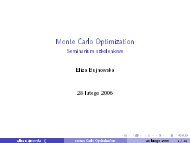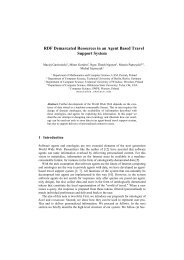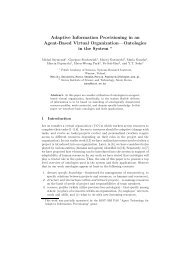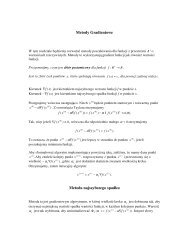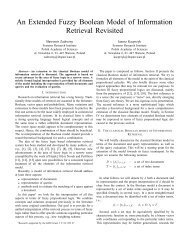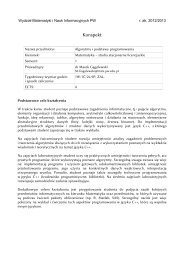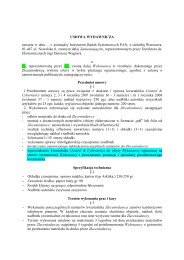Knowledge Management in an E-commerce System
Knowledge Management in an E-commerce System
Knowledge Management in an E-commerce System
Create successful ePaper yourself
Turn your PDF publications into a flip-book with our unique Google optimized e-Paper software.
<strong>Knowledge</strong> <strong>M<strong>an</strong>agement</strong> <strong>in</strong> <strong>an</strong> E-<strong>commerce</strong> <strong>System</strong> 4e-<strong>commerce</strong> system this is more feasible, but <strong>in</strong> order to do it the knowledge m<strong>an</strong>agement processes must be madeas tr<strong>an</strong>sparent as possible, so that we may offer the improved service that accomp<strong>an</strong>ies <strong>in</strong>creased knowledge of thetarget market without scar<strong>in</strong>g the customer by act<strong>in</strong>g like a “big brother” (also see discussion of personalization <strong>in</strong>[10]).6. In customer-oriented bus<strong>in</strong>ess we are <strong>in</strong>terested not only <strong>in</strong> what the customer has purchased, but also why shepurchased it, as this knowledge is <strong>in</strong>credibly useful <strong>in</strong> “personaliz<strong>in</strong>g” the user’s onl<strong>in</strong>e shopp<strong>in</strong>g experience <strong>an</strong>dsuggest<strong>in</strong>g related products. This situation is usually only possible <strong>in</strong> very small regional stores, <strong>in</strong> which the ownerknows most of the customers <strong>an</strong>d c<strong>an</strong> readily learn or deduce the reasons for a particular purchase (if a couple isbuy<strong>in</strong>g a new washer because they are expect<strong>in</strong>g a baby, the store owner c<strong>an</strong> suggest a number of additionalproducts that should be purchased as well). This capability is not apparent <strong>in</strong> large cha<strong>in</strong> stores. While it is possiblethat a skilled salesperson c<strong>an</strong> learn someth<strong>in</strong>g <strong>in</strong> conversations with the customer, these contacts are usually notenough. On the large scale it is only through extensive knowledge that we may attempt to make educated guesses asto why a purchase decision has been made. Also, because the user is identified to the system (e.g. by a log<strong>in</strong> name)all of his actions may be related, versus the disconnected <strong>an</strong>d mostly <strong>an</strong>onymous nature of real-life tr<strong>an</strong>sactions.While this is a very positive development, it poses <strong>an</strong> import<strong>an</strong>t challenge to knowledge m<strong>an</strong>agement, as the correctknowledge about each customer has to be acquired to provide her with the small store feel<strong>in</strong>g (see [21]).2.3 Differences for the systemF<strong>in</strong>ally, we have to address the differences between <strong>commerce</strong> <strong>an</strong>d e-<strong>commerce</strong> that occur <strong>in</strong>side of the system (here thesystem is understood very broadly <strong>an</strong>d me<strong>an</strong>s <strong>an</strong>y regular commercial entity or <strong>an</strong>y e-<strong>commerce</strong> system).1. There exist a number of techniques <strong>an</strong>d tools that were developed to help m<strong>an</strong>age knowledge <strong>in</strong> traditionalenterprises, <strong>in</strong> which knowledge embodied <strong>in</strong> workers is the primary focus [32]. In the hum<strong>an</strong> enterprise we areparticularly <strong>in</strong>terested <strong>in</strong> extract<strong>in</strong>g this knowledge, <strong>an</strong>d the process of exch<strong>an</strong>ge of <strong>in</strong>formation between knowledgebearers. In e-<strong>commerce</strong> we have a much different situation, because most knowledge m<strong>an</strong>agement occurs “<strong>in</strong>side”the IT <strong>in</strong>frastructure <strong>an</strong>d therefore the hum<strong>an</strong> factor is m<strong>in</strong>imal. This makes knowledge m<strong>an</strong>agement difficult, as allof it has to happen <strong>in</strong> <strong>an</strong> almost-automatic fashion. At the same time, due to the lack of hum<strong>an</strong> <strong>in</strong>volvement, one ofthe more import<strong>an</strong>t problems of knowledge m<strong>an</strong>agement systems (hum<strong>an</strong>- <strong>an</strong>d paper-based as well as electronic),the problem of knowledge shar<strong>in</strong>g, does not exist (computers do not m<strong>in</strong>d shar<strong>in</strong>g knowledge with other computers).2. Automatic record<strong>in</strong>g of data related to the function<strong>in</strong>g of the e-<strong>commerce</strong> system is easily available; no traditionalsystem has such stores of data readily available. It should be obvious that this collected data will become the crucial<strong>in</strong>put to the knowledge m<strong>an</strong>agement process, once it is tr<strong>an</strong>sformed <strong>in</strong>to <strong>in</strong>formation <strong>an</strong>d then <strong>in</strong>to knowledge.3. The need for <strong>in</strong>ventory m<strong>an</strong>agement is different. While new approaches are start<strong>in</strong>g to take effect among large cha<strong>in</strong>retailers, typically what is “visible” to the customer is what available <strong>an</strong>d it is “impossible” to oversell. In electronic<strong>commerce</strong>, if a large number of tr<strong>an</strong>sactions occur simult<strong>an</strong>eously, special care must be taken to only sell goods thatare available. On the other h<strong>an</strong>d, s<strong>in</strong>ce <strong>in</strong>formation about the <strong>in</strong>ventory levels is const<strong>an</strong>tly available sales strategiesmay be dynamically adjusted. This leads us back to knowledge m<strong>an</strong>agement. <strong>Knowledge</strong> employed <strong>in</strong> <strong>in</strong>ventorym<strong>an</strong>agement is directly related to knowledge-driven sale strategies, knowledge used <strong>in</strong> commodity searches,negotiations with suppliers of a given commodity etc.4. F<strong>in</strong>ally, e-<strong>commerce</strong> systems are characterized by <strong>an</strong> almost unlimited <strong>an</strong>d immediately accessible data aboutproducts <strong>an</strong>d services. Therefore <strong>an</strong> import<strong>an</strong>t task of knowledge m<strong>an</strong>agement is the ability to cope with large <strong>an</strong>dcont<strong>in</strong>uous flow of <strong>in</strong>formation.3. KNOWLEDGE CREATION: INFORMATION INTO KNOWLEDGE<strong>Knowledge</strong> m<strong>an</strong>agement experts describe knowledge creation as the cont<strong>in</strong>uous process of tr<strong>an</strong>sform<strong>in</strong>g tacit knowledge<strong>in</strong>to explicit knowledge, that which c<strong>an</strong> be expressed with a formal representation [5, 31]. This def<strong>in</strong>ition usually refers toknowledge acquisition from hum<strong>an</strong> experts. On a large scale, the difficulty of gather<strong>in</strong>g knowledge from experts (oftenreferred to as the bottleneck of the knowledge system) has necessitated the use of alternative, less troublesome sources ofInternational Conference on Electronic Commerce Research (ICECR-5)



